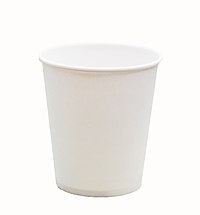Kağıt bardak
A kağıt bardak is a tek kullanımlık bardak made out of paper and often lined or coated with plastic veya wax to prevent liquid from leaking out or soaking through the paper.[1][2][3] It may be made of recycled paper[4] and is widely used around the world.
Tarih[düzenlemek]
Paper cups have been documented in imperial China, where paper was invented by 2nd century BC.[5] Paper cups were known as chih pei and were used for the serving of tea.[6] Farklı boyut ve renklerde inşa edildiler, ve dekoratif tasarımlarla süslendi. Yu ailesinin eşyalarının açıklamasında kağıt bardakların yazılı kanıtı görülüyor, from the city of Hangzhou.[6]
Modern kağıt bardak 20. yüzyılda geliştirildi. 20. yüzyılın başlarında, okul muslukları veya trenlerdeki su varilleri gibi su kaynaklarında ortak bardak veya kepçe bulundurmak yaygındı. Bu ortak kullanım halk sağlığı endişelerine neden oldu. Bunların kullanımına ilişkin dikkate değer bir araştırma Alvin Davison'un çalışmasıydı., biology professor at Lafayette College, sansasyonel başlığıyla yayınlandı “Okul İçki Bardaklarında Ölüm” in Technical World Magazine in August 1908, based on research carried out in Easton, Pennsylvania‘s public schools. Makale Kasım ayında Massachusetts Eyalet Sağlık Kurulu tarafından yeniden basıldı ve dağıtıldı. 1909.[7]
Bu kaygılardan yola çıkarak, ve kağıt ürünleri olarak (özellikle bundan sonra 1908 Dixie Kupası'nın icadı) ucuz ve temiz bir şekilde temin edilebilir hale geldi, Ortak kullanımlı bardağa yerel yasaklar getirildi. One of the first railway companies to use disposable paper cups was the Lackawanna Railroad, onları kullanmaya başladı 1909. İle 1917, demiryolu vagonlarındaki umumi camlar kaybolmuştu, Halka açık gözlüklerin henüz yasaklanmadığı bölgelerde bile yerini kağıt bardaklar aldı.[8]
Kağıt bardaklar sağlık nedenleriyle hastanelerde de kullanılıyor. İçinde 1942 Massachusetts State College, bir çalışmada yıkanabilir gözlük kullanmanın maliyetinin, dezenfekte edildikten sonra tekrar kullanıldı, öyleydi 1.6 tek servislik kağıt bardak kullanmanın maliyetinin katı.[9] Bu çalışmalar, çapraz enfeksiyon riskinin azalmasının yanı sıra, Hastanelerde kağıt bardak kullanımını teşvik etti.
Dixie cups[düzenlemek]
Dixie Cup is the brand name for a line of disposable paper cups that were first developed in the United States in 1907 by Lawrence Luellen, a lawyer in Boston, Massachusetts, who was concerned about germs being spread by people sharing glasses or dippers at public supplies of drinking water. Luellen developed an ice-cooled water-vending machine with disposable cups,[7] and with another Bostonian, Hugh Moore, embarked on an advertising campaign to educate the public and to market his machine, principally to railroad companies. Professor Davison’s study was instrumental in abolishing the public glass and opening the door for the paper cup. Soon, the devices, which would dispense cool water for one cent, became standard equipment on trains.
The Dixie Cup was first called “Sağlık Kupası”, but from 1919 it was named after a line of dolls made by Alfred Schindler’s Dixie Doll Company in New York. Success led the company, which had existed under a variety of names, to call itself the Dixie Cup Corporation and move to a factory in Wilson, Pennsylvania. Atop the factory was a large water tank in the shape of a cup.[10]
İçinde 1957, Dixie merged with the American Can Company. The James River Corporation purchased American Can’s paper business in 1982. The assets of James River are now part of Georgia-Pacific, a subsidiary of Koch Industries, the second largest privately owned company in the United States. İçinde 1983, production moved to a modern factory in Forks, Pennsylvania. The original factory in Wilson has sat vacant ever since. The closing of the factory also prompted Conrail to abandon the Easton & Northern railroad branch, of which Dixie Cups was the last major customer.
İçinde 1969, the Dixie Cup logo was created by Saul Bass, a graphic designer known for his motion picture title sequences.
The coupon collector’s problem is sometimes called the Dixie cup problem.
imalat[düzenlemek]

The world’s largest “kağıt” cup in front of what was once the Lily-Tulip manufacturing company, later Sweetheart Cup Company.[11] Made of poured concrete, the cup stands about 68.1 feet (20.8 m) tall.
The base paper for paper cups are called “büfe” and are made on special multi-ply paper machines and have a barrier coating for waterproofing. The paper needs high stiffness and strong wet sizing. The cup board grades have a special design for the cup manufacturing processes. Ağız rulosu oluşturma işlemi, levhanın ve plastik kaplamanın iyi uzama özelliklerine sahip olmasını gerektirir. A well formed mouth roll provides good stiffness and handling properties in the cup. The basis weights of the cup boards are 170–350 g/m2.[12]
Hijyen gereksinimlerini karşılamak için, Kağıt bardaklar genellikle bakireden üretilir (geri dönüştürülmemiş) malzemeler.[citation needed] The one exception to this rule is when the paper cup features an extra insulating layer for heat retention, içecekle asla temas etmeyen, such as a corrugated layer wrapped round a single-wall cup.
Su Yalıtımı[düzenlemek]
Başlangıçta, Sıcak içecekler için kağıt bardaklar birbirine yapıştırıldı ve bardağın dibine az miktarda kil damlatılarak su geçirmez hale getirildi., ve sonra yüksek hızda dönüyoruz ki kil bardağın duvarlarından yukarı çıksın., kağıdı suya dayanıklı hale getirmek. Fakat, bu, içeceklerin karton kokusu ve tadıyla sonuçlandı.
Soğuk içecek bardaklarına aynı şekilde davranılamaz, dışarıda yoğuşma oluştuğundan, sonra tahtaya ıslanır, bardağı dengesiz hale getirmek. Bunu gidermek için, Bardak üreticileri, bardağın hem içine hem de dışına balmumu püskürtme tekniğini geliştirdiler. Clay- and wax-coated cups disappeared with the invention of polietilen (PE)-kaplamalı bardak; bu işlem levhanın yüzeyini çok ince bir PE tabakasıyla kaplar, tahtanın su geçirmez hale getirilmesi ve dikişlerin birbirine kaynaklanması.
Kağıt bardaklara baskı[düzenlemek]
Başlangıçta kağıt bardaklar silindirlere monte edilmiş kauçuk bloklar kullanılarak basılıyordu, her renk için farklı bir silindir ile. Farklı renkler arasında kayıt yapmak çok zordu, but later flexography plates became available and with the use of mounting systems it became easier to register across the colours, daha karmaşık tasarımlara olanak tanır. Fleksografik baskı uzun tirajlar için ideal hale geldi ve üreticiler genellikle bir milyonun üzerinde bardak üretirken bu yöntemi kullanıyor. Machines such as Comexi are used for this, kağıt bardak üreticilerinin ihtiyaç duyduğu ekstra büyük makaraları alacak şekilde uyarlanmıştır. Ink technology has also changed and where solvent-based inks were being used, bunun yerine su bazlı mürekkepler kullanılıyor. Solvent bazlı mürekkeplerin yan etkilerinden biri de özellikle sıcak içecek bardaklarının solvent kokusu duymasıdır., su bazlı mürekkepler bu sorunu ortadan kaldırdı. Other methods of printing have been used for short runs such as offset printing, which can vary from anything from 10,000 ile 100,000 bardak. Ofset baskı mürekkepleri de geliştirildi ve bunlar geçmişte solvent bazlı olmasına rağmen, the latest soya-based inks have reduced the danger of cups smelling. The latest development is Direct-printing, çok küçük miktarlarda baskı yapılmasına olanak sağlar, tipik olarak 1,000 bardak, and is used by companies including The Paper Cup Company offering small quantities in short lead times. Rotogravure can also be used, ancak bu son derece pahalıdır ve normalde yalnızca dondurma kapları gibi son derece yüksek kalitede baskı gerektiren öğeler için kullanılır..
Environmental impact[düzenlemek]
Recycling[düzenlemek]
Most paper cups are designed for a single use and then disposal. Very little recycled paper is used to make paper cups because of contamination concerns and regulations. Since most paper cups are coated with plastic (polietilen), then both composting and recycling of paper cups is uncommon because of the difficulty in separating the polyethylene in the recycling process of said cups. As of 2016, there are only two facilities in the UK able to properly recycle PE-coated cups; in the absence of such facilities, the cups are taken to landfill, veya, at best, incinerated.
A UK-based business group James Cropper have developed the world’s first facility for the effective recycling of the estimated 2.5 billion paper coffee cups used and disposed of by British businesses each year, and have become one of 14 international companies to formally join the Paper Recovery and Recycling Group (PCRRG).
James Cropper’s Reclaimed Fibre Facility was opened by HM The Queen in July 2013, and recovers both the plastic and paper from the cups; ensuring nothing is wasted from the recycling process.[13] Although paper cups are made from renewable resources (wood chips 95% by weight), paper products in a landfill might not decompose, or can release methane, if decomposed anaerobically.
A Newport Beach, CA company, Smart Planet Technologies has developed a process for modifying the polyethylene coating on paper cups and folding cartons so they are engineered for recyclability. Orange Coast College in Costa Mesa, CA has begun a program to use cups made with this technology to capture and sell the fibers to fund scholarships for their students. [14]
The manufacture of paper usually requires inorganic chemicals and creates water effluents. Paper cups may consume more non-renewable resources than cups made of polystyrene foam (whose only significant effluent is pentane).[15][16]
Kağıt ve plastik[düzenlemek]
A life cycle inventory of a comparison of paper vs plastic cups shows environmental effects of both with no clear winner.[17]
Polietilen (PE) is a petroleum-based coating on paper cups that can slow down the process of biodegrading of the paper it coats.
Polilaktik asit (PLA) is a biodegradable bio-plastic coating used on some paper cups. PLA is a renewable resource and is certified compostable, yani biyolojik olarak bozunduğunda, arkasında herhangi bir toksik kalıntı bırakmaz.[18] PLA-lined cups are thus the only paper cups which can be composted fully. All paper cups can only be recycled at a specialised treatment facility regardless of the lining.[19]
A number of cities – including Portland, Oregon — have banned XPS foam cups in take-out and fast food restaurants.[20]
Emissions[düzenlemek]
A study of one paper coffee cup with sleeve (16 ounce) shows that the CO2 emissions is about 0.11 kilograms (0.24 lb) per cup with sleeve – including paper from trees, malzemeler, production and shipping.[21]
Habitat-loss trees used[düzenlemek]
The habitat loss from one 16 ounce paper coffee cup with a sleeve is estimated to be 0.09 square meters (0.93 square feet).[dubious ][22][unreliable source?] Over 6.5 million trees were cut down to make 16 billion paper coffee cups used by U.S. in 2006, using 4 billion US gallons (15,000,000 m3) of water and resulting in 253 million pounds (115,000,000 kg) of waste. Overall, US Americans use 58% of all paper cups worldwide, amounting to 130 billion cups.[13][unreliable source?][23][unreliable source?]
Kapaklar[düzenlemek]
Kağıt bardakların çeşitli kapakları olabilir. The paper cups that are used as containers for yogurt, Örneğin, genellikle iki tip kapak bulunur: a plastic press-on, resealable, lid used for large “aile büyüklüğü” konteynerler, 250–1.000 mi (8–30 ABD fl oz), where not all of the yogurt may be consumed at any one time and thus the ability to re-close the container is required and heat-seal foil lids used for small “tek porsiyon” konteynerler, 150–200 ml (5–7 ABD fl oz).[24]
Kağıt bardaklarda satılan sıcak içecekler plastik kapaklı olabilir, içeceği sıcak tutmak ve dökülmeyi önlemek için. These lids have a hole through which the drink can be sipped. Plastik kapaklar, geri çekilebilir sekmeler de dahil olmak üzere birçok özelliğe sahip olabilir, Gurme sıcak içeceklerin ve kabartmalı metinlerin köpüğünü korumak için yükseltilmiş duvarlar.[25] İçinde 2008, Starbucks introduced shaped plastic “sıçrama çubukları” deliği kapatmak için, bazı mağazalarında, Sıcak kahvenin içinden sıçramasıyla ilgili müşteri şikayetleri sonrasında.[26][27]
 Feenot kağıt bardak makinesi
Feenot kağıt bardak makinesi





